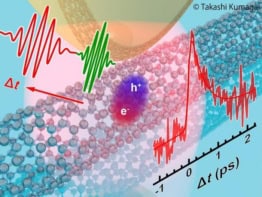Two groups of physicists have shown that carbon nanotubes respond to magnetic fields in ways that are not seen in other materials. Junichiro Kono and colleagues at Rice University and Florida State University and Alexey Bezryadin and co-workers at the University of Illinois at Urbana-Champaign have discovered that semiconducting nanotubes can be made metallic, and vice versa, by applying a magnetic field. In addition to their fundamental importance, the results could have practical applications (Science 304 1129 and 1132).
Carbon nanotubes are essentially rolled up sheets of graphite, just nanometres in diameter, that can be metallic or semiconducting depending on the direction in which the sheet has been rolled up. Kono and co-workers performed optical absorption and emission spectroscopy on solutions of semiconducting single wall nanotubes placed in strong magnetic fields of 45 Tesla. They found that the band gap between the conduction and valence bands in the nanotubes became smaller as the strength of the magnetic field was increased.
“This phenomenon is unique among known materials,” Kono told PhysicsWeb. “Ordinary semiconductors show the opposite behaviour.” The team believes that the band gap could disappear completely in higher fields, which would cause the semiconducting nanotubes to become metallic.
Meanwhile, Bezryadin and colleagues found that the band gap in a multi-walled metallic nanotube — which was initially zero — gradually widened as a magnetic field was applied, turning it into a semiconductor. Moreover, as the applied field was increased further, the band gap dropped back to zero and the nanotube became a metal again.
Although these effects have never been observed in nanotubes before, they agree with theoretical predictions. Both experiments also highlight the importance of a subtle quantum effect known as the Aharonov-Bohm effect. Although this effect has been observed in many systems before, including nanotubes, this is the first time that it has been shown to have an effect on the band structure of a solid.
“The discovery could lead to novel magneto-optical or magneto-electrical switching devices by magnetically controlling the metallicity of nanotubes,” Kono told PhysicsWeb. “It could also lead to novel experiments on one-dimensional systems.”
“Our work demonstrates that hollow molecules can change the energies of their orbitals in response to the magnetic flux threaded through the molecule,” said Bezryadin. “This observation may have interdisciplinary importance, since electronic orbitals not only determine the energy of the molecule but also its chemical, mechanical and other properties. It might therefore be possible to control these properties by a magnetic field.”
Kono’s group now plans to study the effects of even stronger magnetic fields on nanotubes, while Bezryadin and co-workers will repeat their experiment at ultracold temperatures to obtain an even clearer picture of how the electron energy levels in the nanotubes respond to magnetic fields.



